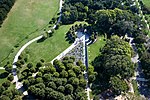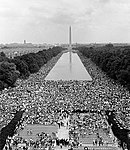Washington metropolitan area

The Washington metropolitan area, also commonly referred to as the National Capital Region, is the metropolitan area centered on Washington, D.C., the capital of the United States. The area includes all of the District of Columbia and parts of the states of Maryland, Virginia and West Virginia. It is part of the larger Baltimore–Washington metropolitan area. The Washington metropolitan area is one of the most educated and most affluent metropolitan areas in the US. The metro area anchors the southern end of the densely populated Northeast megalopolis with an estimated total population of 6,385,162 as of the 2020 U.S. Census, making it the sixth-largest metropolitan area in the nation and the largest metropolitan area in the Census Bureau's South Atlantic division.
Excerpt from the Wikipedia article Washington metropolitan area (License: CC BY-SA 3.0, Authors, Images).Washington metropolitan area
Elm Walk, Washington
Geographical coordinates (GPS) Address Nearby Places Show on map
Geographical coordinates (GPS)
| Latitude | Longitude |
|---|---|
| N 38.89 ° | E -77.046666666667 ° |
Address
Vietnam Women's Memorial
Elm Walk
20227 Washington
District of Columbia, United States
Open on Google Maps











